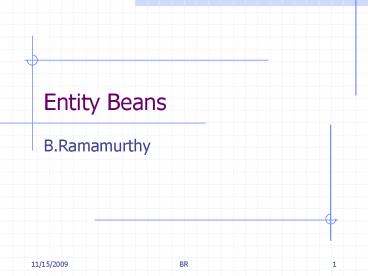Entity Beans - PowerPoint PPT Presentation
Title:
Entity Beans
Description:
Corresponds to a relation/table in a relational database ... container uses these methods to synchronize the instance variables of an entity ... – PowerPoint PPT presentation
Number of Views:72
Avg rating:3.0/5.0
Title: Entity Beans
1
Entity Beans
- B.Ramamurthy
2
Entity Bean
- Persistent
- Corresponds to a relation/table in a relational
database - Each instance of the bean corresponds to a row in
the relational table - Database entry possible created by SQL
- CREATE TABLE savingsaccount
- (id VARCHAR(3) CONSTRAINT pk_savingsaccount
PRIMARY KEY, firstname VARCHAR(24), lastname
VARCHAR(24), balanace NUMERIC(10,2))
3
Savings Account Code
- Entity bean class SavingsAccountBean
- Home interface SavingsAccountHome
- Remote interface SavingsAccount
- Utility class InSufficientBalanceException
- Client SavingAccountClient
4
Entity Bean Class
- Implements
- Entity bean interface
- Zero or more ejbCreate and ejbPostCreate methods
- Finder methods
- Business methods
- Home methods
5
EJBCreate Method
- Inserts the entity into the database
- Initializes the instance variables
- Returns primary key
- Lets look at the code.
- Access control is public, return type is primary
key, arguments are legal Java RMI types, method
modifier cannot be final or static.
6
EJBremove
- Client deletes the entity bean by invoking this
method. Deletes the entity from the state of the
database. - Equivalent to deleting the row from the
relational table.
7
EJBLoad and EJBStore
- EJB container uses these methods to synchronize
the instance variables of an entity bean with the
corresponding values stored in the database, - ejbLoad method refreshes the instance variables,
and the ejbStore method writes the variables to
the database.
8
Finder methods
- Finder methods allow clients to locate entity
beans. - The SavingAccountClient program locates entity
bean with three finder methods - SavingsAccount jones home.findByPrimaryKey(836
) - Collection c home.findByLastName(Smith)
- Collection c home.findInRange(20.0, 99.0)
- For every finder method available to client, the
entity bean must implement a corresponding method
that begins with a prefix ejbFind. Lets check the
code.
9
Business Methods
- The business methods contain the business logic
that you want to encapsulate within the entity
bean. - Usually business methods do not access the
database, allowing you to separate the business
logic from the database access code. - Lets examine the methods.
10
Home methods
- A home method contains the business logic that
applies to all entity beans of a particular
class. - In contrast logic of a business that applies to a
single entity bean, an instance with unique
identity. - Consequently home method must not access the
beans persistence state or in other words
instance variables. - Typically a home method locates a collection of
bean instances and invokes business methods as it
iterates through the collection. - Charge for low balance is an example.
11
SQL statements in SavingsAccountBean DB calls
12
Finally,
- Examine the home interface, remote interface
code. - Open, deploy and run the example.
- You may have to set up the database, in this case
cloudscape. - Later I will show you hot to access our Oracle db
with the help of the j2eeadmin tool.































